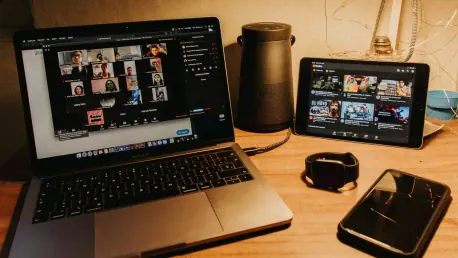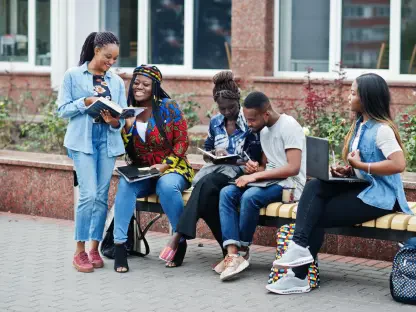The COVID-19 pandemic acted as a catalyst for educational institutions worldwide, pushing them to adopt digital tools to continue teaching. Among these tools, Zoom emerged as a front-runner, offering a semblance of academic normalcy in unprecedented times. While Zoom’s role in education was invaluable during the pandemic, its long-term efficacy remains contentious, raising questions about its impact on student engagement, focus, and academic performance.
Post-Pandemic Adoption and Usage Trends
Surge in Adoption
The onset of the pandemic saw Zoom transforming from a relatively unknown platform to a household name. With educational institutions shut down, Zoom’s daily visits skyrocketed from 2 million during the pandemic to a staggering 3 million by 2024. Schools and universities quickly integrated Zoom into their curriculum as a temporary solution to an unprecedented crisis. This sudden rise in adoption highlighted the platform’s crucial role in enabling education to continue during periods when physical classrooms were no longer viable. However, this surge came with its own set of challenges, as institutions and students had to rapidly adapt to a new mode of learning that many were unprepared for.
The rapid shift to Zoom did more than just provide a temporary solution; it fundamentally altered the way education was perceived. The convenience of attending classes from any location brought a sense of flexibility, albeit accompanied by a steep learning curve. Not only did it ease the continuity of courses, but it also posed significant hurdles in terms of both technology and engagement. As the pandemic extended, the reliance on Zoom grew, embedding itself into the daily routine of students and educators alike. This period of extensive use allowed for a detailed observation of its strengths and weaknesses, leading many to question its sustainability as a long-term educational tool.
Institutional Integration
Many academic institutions made Zoom their primary mode of delivering lectures and conducting daily administrative activities. This shift was necessitated by social distancing mandates and lockdown measures, making in-person instruction impossible. Teachers and students alike had to navigate this new digital landscape rapidly, with varying degrees of success. Schools implemented a variety of strategies to maximize the effectiveness of Zoom, from redesigning curriculums to fit online formats to training educators on the nuances of virtual teaching. Yet, the experience varied widely; some schools flourished under this new model, while others struggled to maintain the same level of academic rigor and student engagement.
Despite the vast efforts to integrate Zoom effectively, the platform’s limitations became increasingly evident over time. Teachers faced difficulties in adapting their teaching styles to a virtual setting, often finding it hard to gauge student comprehension and participation. On the flip side, students were confronted with the challenge of staying focused in an environment filled with distractions. The absence of a structured classroom and face-to-face interaction created a learning gap that technology alone couldn’t bridge. Moreover, the essential components of education that thrive on spontaneous interactions and real-time feedback were severely compromised, raising concerns over the long-term implications of an over-reliance on Zoom.
Technical Difficulties and Learning Productivity
Internet Connectivity Issues
One of the most significant barriers to effective learning on Zoom has been technical difficulties, particularly unstable internet connections. Frequent internet outages and audio problems disrupt the flow of classes, leading to gaps in understanding and retention of material. These technical challenges not only frustrate students but also hinder effective communication between instructors and their pupils. The issue of digital inequality also came to the forefront, as not all students had equal access to high-speed internet or the latest technology, thereby exacerbating the discrepancies in learning experiences.
The compounded effect of these technical issues was a significant decline in the quality of education during extended periods of virtual learning. Students found it increasingly difficult to follow along with lessons, resulting in inconsistent academic performance. The interruptions from poor connectivity and technical malfunctions created an environment where sustained focus was nearly impossible, making the educational experience more about troubleshooting than actual learning. Both teachers and students were frequently pulled away from the academic content to resolve these issues, significantly diminishing the effectiveness of virtual classes.
Classroom Dynamics and Focus
The intrinsic structure of traditional classrooms, which fosters concentration and order, is notably absent in virtual environments. Many students report struggling to maintain focus during Zoom classes due to a multitude of distractions at home. Unlike a physical classroom, where the atmosphere is conducive to learning, Zoom sessions can easily be interrupted by external factors, be it family members, pets, or even the temptation of multitasking. The lack of a designated, structured space for learning compromises the ability of students to engage fully with the material being taught.
Moreover, the psychological separation from a physical learning environment further diminishes the effectiveness of Zoom classes. Traditional classrooms offer an immersive atmosphere that naturally encourages students to engage in discussions, ask questions, and participate actively. This dynamic is challenging to replicate in a virtual setting, where students often feel more like passive observers rather than active participants. The absence of immediate, real-time feedback from peers and instructors leads to a disengaged learning experience, making it harder for students to stay motivated and invested in their education. This lack of interaction and engagement manifests in lower academic performance and a declining interest in schoolwork.
Student Engagement: A Diminished Experience
Engagement Shortfalls
The face-to-face interactions and spontaneous discussions that characterize traditional classrooms are hard to replicate in a virtual setting. Students like Aleigha Lowry and Kiera Carlton emphasize that the in-person dynamic contributes significantly to their understanding and participation, elements that Zoom fails to capture effectively. The lack of immediate feedback and live engagement reduces the incentive for students to participate actively. This disengagement reveals itself in dulled academic performance, lowered enthusiasm for course material, and a general sense of disconnection from the educational process.
Traditional classroom interactions provide invaluable cues that help teachers gauge student comprehension and engagement. These organic exchanges often drive the momentum of a lesson, allowing teachers to adjust their teaching based on real-time feedback. Zoom, however, lacks the capacity to fully emulate this dynamic. The platform’s limitations in fostering spontaneous discussions hamper the collaborative spirit that typically flourishes in physical classrooms. The result is a less vibrant educational environment where students become passive recipients of information rather than active co-creators in their learning journey. This shift not only affects academic outcomes but also hampers the development of critical thinking and interpersonal skills.
Peer Interaction and Group Work
Group projects and collaborative learning experiences suffer greatly in a virtual environment. The absence of direct social interaction hampers teamwork and the organic collaborative learning that often occurs in physical settings. Students miss out on peer exchanges that enrich their academic experience, making Zoom classes feel isolating and less motivating. The serendipitous conversations and spontaneous problem-solving that occur in traditional classrooms are hard to translate into virtual settings. This lack of direct peer interaction can lead to feelings of isolation, further diminishing the overall educational experience.
The challenge extends to structured group assignments as well. Coordinating group efforts requires more than just sharing a screen; it involves nuanced communication and shared physical presence that fosters collaboration. While Zoom offers breakout rooms to facilitate group work, these virtual spaces rarely capture the dynamic energy of in-person collaboration. The impersonal nature of virtual interactions often reduces group work to a transactional process, rather than a rich, engaging activity that encourages innovative thinking and collective problem-solving. Consequently, students are less likely to feel a sense of community and shared purpose, undermining the collaborative aspect of education that is crucial for their academic and personal growth.
Impact on Social Interactions and Mental Health
Feeling of Isolation
The shift to virtual learning has markedly reduced social interactions among students. Traditional education settings offer numerous opportunities for socializing, from casual conversations between classes to group study sessions. The isolation imposed by prolonged virtual learning can lead to feelings of loneliness and detachment, negatively affecting students’ mental health and well-being. The lack of face-to-face interaction removes the human element from education, making it harder for students to build relationships and support networks that are crucial for their emotional and social development.
While Zoom allows for digital interaction, it doesn’t adequately replace the depth and quality of in-person connections. The absence of physical presence and shared experiences diminishes the sense of community and belonging that traditional educational settings naturally foster. Students often feel isolated, struggling to find motivation and support in a virtual environment. This sense of isolation can exacerbate already existing mental health issues, leading to increased feelings of anxiety, stress, and depression. The challenge lies in finding ways to foster meaningful connections and support mechanisms within the constraints of virtual learning platforms.
Mental Health Concerns
The absence of a structured, communal learning environment can exacerbate stress and anxiety levels among students. Being physically away from peers and teachers can result in a sense of disconnection and decreased motivation. This mental health toll adds another layer of complexity to the challenges posed by virtual learning, necessitating proactive measures to support student well-being. The constant screen time and lack of physical activity also contribute to the deterioration of mental and physical health, making students feel more lethargic and less engaged.
In addition to the lack of social interaction, the virtual learning environment often imposes unrealistic expectations on students to remain self-disciplined and motivated. The blurred boundaries between home and school life can make it difficult for students to establish a routine, leading to burnout and overwhelming stress. Schools need to recognize these mental health challenges and implement strategies to provide emotional and psychological support. This could include virtual counseling sessions, mental health workshops, and creating opportunities for social interaction within the constraints of the digital platform. Addressing these mental health concerns is crucial for ensuring that students remain resilient and capable of navigating this new educational landscape.
Comparative Analysis: Virtual vs. Traditional Classrooms
Advantages of Traditional Classrooms
Traditional classrooms inherently encourage engagement through physical presence, allowing for spontaneous interactions and immediate feedback. Students benefit from the structured environment and the dynamic exchange of ideas that a physical setting offers. The ability to gauge reactions, ask questions in real-time, and have impromptu discussions are advantages that Zoom is yet to replicate. The collaborative nature of in-person learning provides a richer, more immersive experience that fosters critical thinking and creativity.
Moreover, the structured environment of a traditional classroom helps maintain discipline and focus, essential elements for effective learning. Teachers can better manage the class, ensuring that students remain attentive and engaged. The physical presence of peers and instructors creates a dynamic atmosphere that is conducive to active participation and deeper learning. The spontaneous and organic nature of interactions in a traditional classroom setting enhances the overall educational experience, making it more engaging and fulfilling for students. This environment not only aids in academic achievement but also in the development of social and interpersonal skills.
Limitations of Virtual Classrooms
Despite the convenience and flexibility that Zoom offers, it falls short in several critical areas compared to traditional classrooms. The absence of direct interaction and the physical separation from peers and instructors contribute to a less immersive learning experience. The consensus among students and educators is clear: while Zoom served an essential purpose during the pandemic, it cannot replace the breadth and depth of in-person learning experiences. The lack of real-time, face-to-face communication hinders the ability to fully engage students, resulting in reduced participation and interest in the learning process.
Furthermore, the limitations of virtual classrooms extend to the types of learning activities that can be effectively conducted. Hands-on experiments, group projects, and interactive discussions are challenging to execute with the same level of efficacy as in a physical setting. The digital divide also plays a significant role, as not all students have equal access to the technology and resources required for successful virtual learning. These limitations highlight the need for a more balanced approach to education, one that leverages the strengths of both virtual and traditional methods to create a more holistic learning experience.
Balancing Virtual and Traditional Teaching Methods
Hybrid Models
As the world moves towards post-pandemic normalcy, a hybrid model of education that combines the benefits of both virtual and traditional methods is gaining traction. This approach seeks to leverage the flexibility of Zoom while reinstating the critical aspects of in-person interactions that enhance learning. By integrating both models, educational institutions can create a more flexible and adaptive learning environment that accommodates diverse student needs and learning styles. Hybrid models offer the best of both worlds, providing the convenience of virtual learning without sacrificing the depth and engagement of traditional classrooms.
The hybrid approach also allows for a more personalized learning experience, tailoring educational content and delivery methods to individual student needs. By incorporating in-person elements, schools can ensure that students receive the social interaction and hands-on learning opportunities that are crucial for their development. At the same time, virtual components can supplement classroom instruction, offering additional resources and flexibility. This balanced approach not only addresses the limitations of both virtual and traditional methods but also prepares students for the increasingly digital world they will navigate in their future careers.
Future Implications
The global COVID-19 pandemic forced educational institutions to rapidly integrate digital tools to maintain teaching continuity. Amidst this digital shift, Zoom stood out as a leading platform, providing a sense of academic normalcy in an otherwise chaotic period. Its video conferencing capabilities allowed students and teachers to connect, ensuring that education could persist despite physical school closures. However, the long-term effectiveness of Zoom in education remains a topic of debate. Questions have arisen regarding its impact on student engagement, concentration, and overall academic performance. Did Zoom’s accessibility genuinely benefit student learning, or did it merely serve as a temporary fix? As schools transition back to in-person learning or continue with a hybrid model, the lasting implications of relying on digital platforms like Zoom for education are being examined. Educators and policymakers are now tasked with evaluating whether these tools can permanently enhance the education system or if they will primarily be remembered as emergency measures during an extraordinary time.









